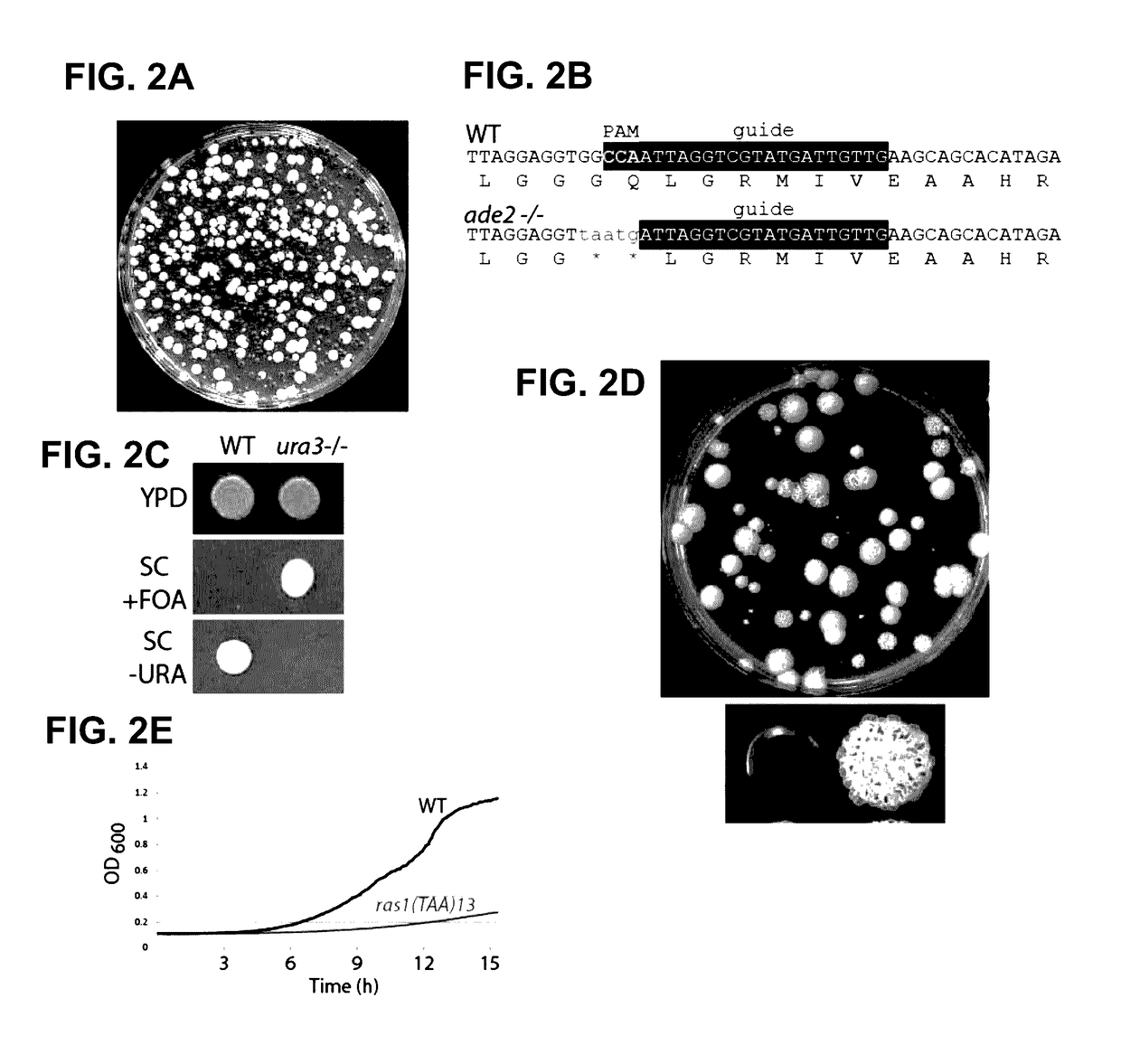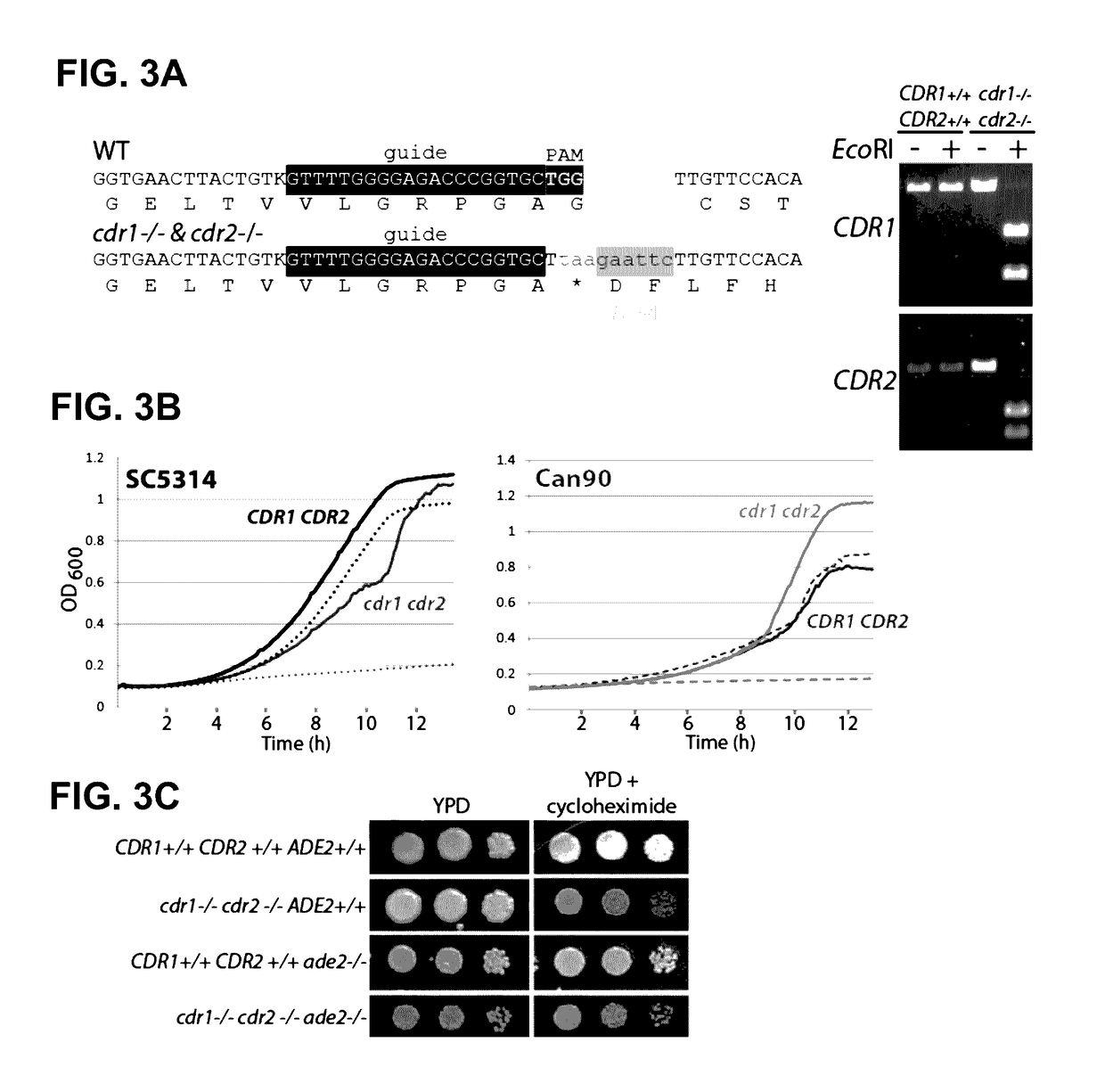Compositions And Methods For Genetically Modifying Yeast
- Summary
- Abstract
- Description
- Claims
- Application Information
AI Technical Summary
Benefits of technology
Problems solved by technology
Method used
Image
Examples
Example
Example 1. Design of a CRISPR System for Use in Candida
[0111]To create a CRISPR system for Candida, several aspects of Candida were considered: the Cas9 gene was recoded because the leucine CUG codon is predominantly translated as serine, there are no known autonomously replicating plasmids, and there are no expression systems for small RNAs. To express a Candida-compatible Cas9 encoding DNA, a Candida / Saccharomyces-codon-optimized version of Cas9 (CaCas9) that avoids the use of the CUG codon was synthesized, ensuring compatibility with all CTG-clade species, as described herein. The CaCas9 gene (SEQ ID NO:2) was fused to sequences encoding the SV40 nuclear localization signal (NLS) and FLAG-tag (e.g., SEQ ID NO:4), for in-frame fusion to the 3′ end of the CaCas9 gene. The CaCas9 from this construct is expressed from the constitutive ENO1 promoter at the plasmid integration site. As there are no autonomously replicating plasmids in Candida, this construct was integrated by transfor...
Example
Example 2. CaCas9 System Enables Highly Efficient Mutagenesis in Candida
[0115]Both the Duet and Solo systems produce red ade2 / ade2 transformants at high frequency (FIG. 2A, FIG. 6A, and FIG. 7B); each system uses a functional Cas9, an sgRNA against ADE2 (representing the desired target in the present example), and the complementary repair template spanning the cut site. In the absence of any one of these components only white ADE2+ colonies were obtained (FIGS. 6A-6D and FIGS. 7A-7D). The Duet system produced 20-40% red colonies among the transformants, and these were authentic CRISPR induced mutations as sequencing of the ade2 / ade2 mutants revealed the UAA and the PAM mutation in the ade2 gene (FIG. 2B). The Solo system was more efficient than the Duet system; 60-80% of the transformants were red ade2 / ade2 mutants (FIG. 2A and FIG. 7B). The frequency of targeting was so high that transformation with Solo plasmid and the repair template for ade2 without any selection for integratio...
Example
Example 3. Use of CaCas9 CRISPR to Target Essential Functions in Candida
[0122]Homozygous loss of function mutations in essential genes of Candida albicans were obtained using the present CRISPR system by creating conditional alleles. Null alleles of DCR1, which is required for rRNA processing, are lethal at low temperature but viable at high temperature (Bernstein, et al., Proc Natl Acad Sci USA 109:523-528 (2012)). Transformation of SC5314 was carried out using the Solo CRISPR plasmid containing a guide directed against DCR1, and a repair template which introduced a stop codon. The transformation plates were incubated at 37° C., and transformants were screened for growth at either 37° C. or 16° C. to identify candidate dcr1 / dcr1 mutants. A number of dcr1 / dcr1 mutants that failed to grow at 16° C. were identified and the signature nonsense mutation confirmed (FIG. 4A and FIG. 8).
[0123]Another approach to obtaining null mutations in lethal functions is to replace the resident functi...
PUM
| Property | Measurement | Unit |
|---|---|---|
| Fraction | aaaaa | aaaaa |
| Composition | aaaaa | aaaaa |
Abstract
Description
Claims
Application Information
 Login to View More
Login to View More - R&D Engineer
- R&D Manager
- IP Professional
- Industry Leading Data Capabilities
- Powerful AI technology
- Patent DNA Extraction
Browse by: Latest US Patents, China's latest patents, Technical Efficacy Thesaurus, Application Domain, Technology Topic, Popular Technical Reports.
© 2024 PatSnap. All rights reserved.Legal|Privacy policy|Modern Slavery Act Transparency Statement|Sitemap|About US| Contact US: help@patsnap.com










